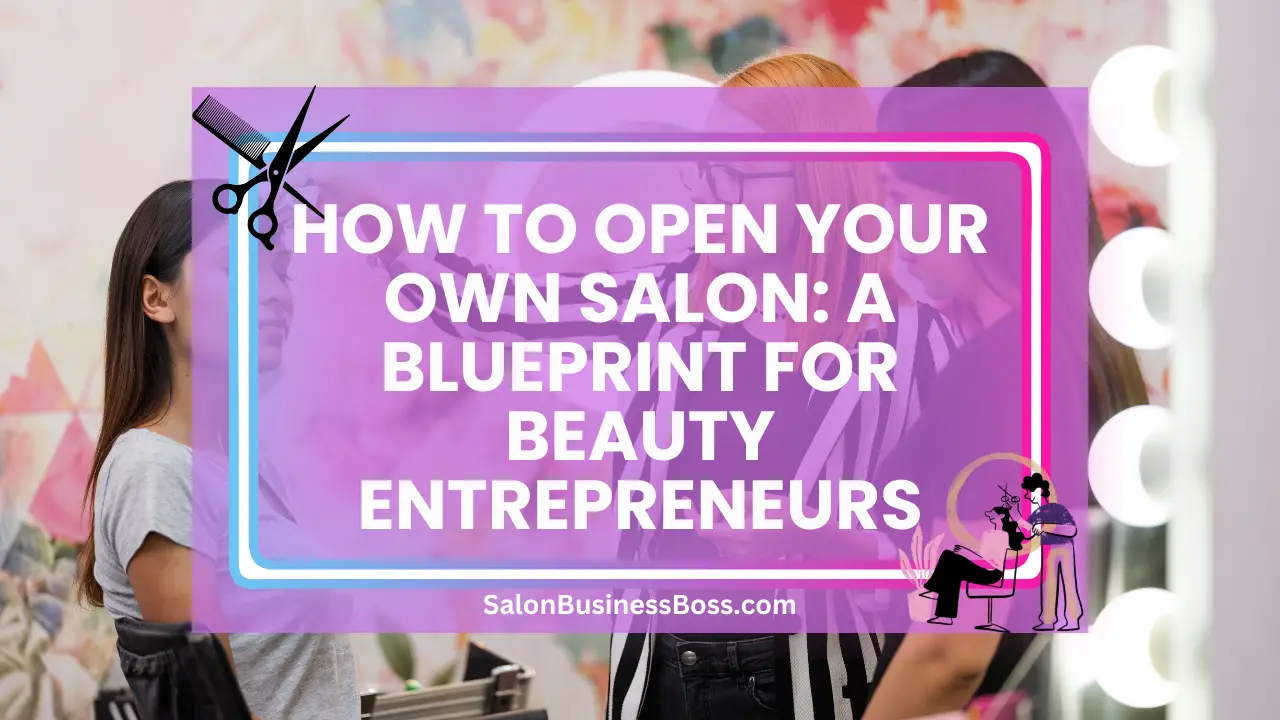Opening your own salon can be a rewarding and fulfilling venture for anyone passionate about the beauty and wellness industry. It offers an opportunity to turn your creativity into a successful business while providing top-notch services to your clients. However, starting a salon requires careful planning, attention to detail, and a clear understanding of the market and industry dynamics.
To open your own salon, begin by conducting thorough market research to understand the demand and competition. Create a comprehensive business plan outlining objectives, target audience, and marketing strategies. Choose a strategic location with high visibility. Comply with legal requirements, design an inviting interior, invest in quality equipment, and build a skilled team. Focus on effective marketing and promotions to attract clients.
1. Conducting Market Research

Before embarking on your journey to open a salon, conducting comprehensive market research is an indispensable step. Market research allows you to gain valuable insights into the local beauty and wellness industry, enabling you to make informed decisions and tailor your salon to meet the specific needs of your target audience.
By understanding the local market demand, you can identify which beauty services are most sought after and which areas may be underserved. Analyzing demographic data will help you determine the preferences and buying behaviors of your potential customers, allowing you to create a salon experience that resonates with them.
Researching the competition provides a clear understanding of what other salons in your area offer and how you can differentiate your business. Identifying gaps in the market and areas of opportunity can be pivotal in shaping your salon’s unique value proposition.
Pricing trends and customer preferences play a crucial role in defining your salon’s service menu and pricing strategy. This research empowers you to strike a balance between competitive pricing and maintaining profitability.
In essence, market research serves as the foundation for developing a successful salon business. Armed with this valuable data, you can confidently create a salon concept that caters to the needs and desires of your target clientele, positioning your salon for long-term success and growth.
Read more about: How to Create a Buzz and Attract Clients: Salon Marketing Tactics
2. Creating a Business Plan
A well-crafted business plan is a roadmap to transform your salon dream into a thriving reality. It is a detailed document that outlines your salon’s mission, objectives, and strategies for achieving success.
Your business plan should start with a clear description of your salon’s vision and mission, laying the groundwork for your salon’s identity and values. Define your target audience and specify how your services will cater to their needs.
Financial projections are a crucial component of the business plan. Estimating your startup costs, operating expenses, and revenue projections will provide insights into the financial feasibility of your salon venture. This information is invaluable when seeking funding from potential investors or financial institutions.
The organizational structure of your salon, including the roles and responsibilities of employees, is another essential aspect to include in the business plan. This ensures a clear and organized workflow, leading to efficient salon operations.
Elaborate on your salon’s service menu, showcasing the range of beauty services you plan to offer. Include details about any unique or specialized services that set your salon apart from competitors.
Outline your marketing and promotional strategies to attract customers and build a loyal clientele. A strong marketing plan will help spread the word about your salon, leading to increased visibility and customer engagement.
3. Choosing the Right Location
Selecting the perfect location for your salon is a critical decision that can have a significant impact on its success. A prime location with high foot traffic and visibility is vital to attract potential customers and build a strong client base. Look for areas that are easily accessible to your target audience, whether it’s in a bustling shopping district, near residential neighborhoods, or close to office complexes.
Being in proximity to complementary businesses, such as fashion boutiques, gyms, or spas, can also boost your salon’s visibility and attract walk-in clients. A well-chosen location can create a symbiotic relationship with neighboring businesses, providing opportunities for cross-promotion and mutual support.
However, it’s essential to balance the benefits of a prime location with the associated costs. Analyze the rental or lease costs of potential locations and ensure they align with your budget constraints. A location that is too expensive might eat into your profits, while one that is too cheap may lack the visibility needed to attract customers.
Before finalizing a location, conduct thorough research on the area’s demographics and competitors. Understanding the local market dynamics will help you gauge the demand for beauty services and assess the level of competition in the vicinity.
4. Legal Requirements and Permits
Compliance with legal requirements and obtaining the necessary permits and licenses is a fundamental step in setting up and running your salon. Each region and country may have specific regulations governing the operation of salons, and it’s crucial to adhere to them to avoid legal complications and potential penalties.
First and foremost, you will need to obtain a business license to legally operate your salon. This license is typically issued by the local government and is essential for conducting business activities within the designated area.
Health department approvals are critical for maintaining hygiene and safety standards in your salon. Inspections and certifications are often required to ensure that your salon follows proper sanitation and health protocols.
You may need tax identification numbers and employer identification numbers, depending on the size and structure of your salon business. These identification numbers are essential for tax purposes and employee-related matters.
If you plan to offer specialized services, such as tattooing or hair extensions, you might require additional occupational licenses or certifications. It’s essential to research and understand the specific requirements for the services you intend to provide.
By taking care of the legal obligations and obtaining the necessary permits and licenses upfront, you create a solid foundation for your salon’s operations. Ensuring compliance demonstrates professionalism and instills confidence in both clients and potential investors or partners. Remember to stay informed about any updates or changes in regulations to maintain your salon’s legal status throughout its operation.
5. Salon Layout and Interior Design

The interior design and layout of your salon are instrumental in creating an inviting and enjoyable experience for your clients. A well-designed salon not only enhances the overall atmosphere but also influences customer perceptions and satisfaction. Hiring a professional interior designer who specializes in salon setups can make a significant difference in achieving the desired ambiance.
Consider the flow and functionality of the salon when planning the layout. Optimize space utilization to ensure that the salon has designated areas for different services while maintaining a comfortable distance between stations. A well-organized layout contributes to efficient workflow and minimizes client wait times, enhancing the overall customer experience.
The atmosphere of the salon is equally important. Create a relaxing environment by incorporating soothing colors, soft lighting, and comfortable furniture. Pay attention to the decor, choosing elements that align with your salon’s branding and vision. The interior design should reflect your salon’s personality and aesthetics, creating a memorable and distinctive experience for clients.
Prioritize cleanliness and hygiene in the design. Ensure that the salon has adequate storage space to keep equipment, supplies, and tools neatly organized. A clean and clutter-free environment not only appeals to clients but also fosters a sense of professionalism among your team.
Read more about: How to Run a Flourishing Salon: Steps to Achieve Growth
6. Equipment and Supplies
Investing in high-quality salon equipment and supplies is a fundamental aspect of running a successful salon. The right tools and products are essential for providing exceptional services and ensuring customer satisfaction.
First and foremost, ensure that you have the necessary salon equipment for each service you offer. Styling chairs, shampoo stations, hair dryers, and manicure/pedicure stations are some of the basic essentials. Opt for ergonomic and comfortable equipment that promotes both the well-being of your clients and the efficiency of your staff.
Invest in high-performance haircare and skincare equipment to deliver top-notch results to your clients. High-quality equipment not only improves the quality of services but also contributes to a professional and upscale image for your salon.
Stock up on top-quality beauty products, hair care items, and skincare products from reputable suppliers. Use professional-grade products that are effective and safe for your clients’ needs. Offering a wide range of trusted brands and products can enhance customer satisfaction and encourage repeat visits.
Regularly inspect and maintain your salon equipment and tools to ensure they are in excellent working condition. Timely maintenance and replacement of worn-out items are essential for consistent service delivery.
By prioritizing the quality of equipment and supplies, you demonstrate a commitment to excellence and create a positive and enjoyable experience for your clients. This investment in your salon’s infrastructure not only enhances customer satisfaction but also contributes to the long-term success and reputation of your salon.
7. Building a Talented Team
The success of your salon hinges on the expertise and dedication of your team. Recruiting a talented group of professionals is paramount to delivering exceptional services and building a loyal clientele. Seek individuals who not only possess outstanding skills in their respective fields but also share your passion for providing top-notch customer service.
Conducting thorough interviews and skill assessments during the hiring process is essential to ensure that you select the best candidates for your salon. Look for individuals who exhibit creativity, attention to detail, and a genuine enthusiasm for their craft. Assess their ability to work well under pressure and maintain a positive attitude when interacting with clients.
Consider cultural fit and alignment with your salon’s vision and values. Employees who are passionate about contributing to the salon’s growth and success will be more engaged and motivated to excel in their roles.
Invest in continuous training and development opportunities for your team to keep their skills updated and enhance their expertise. This not only improves the quality of services but also fosters a sense of loyalty and commitment among your staff.
By building a talented team, you create a supportive and high-performing work environment that fosters creativity and innovation. Satisfied employees are more likely to go the extra mile to ensure client satisfaction, which, in turn, leads to positive word-of-mouth and loyal clientele.
8. Marketing and Promotion
Establishing a robust marketing and promotion strategy is essential for attracting and retaining clients in the competitive beauty industry. Emphasize both online and offline channels to build a strong and visible brand presence.
A professional website is a cornerstone of your online presence. Ensure that it showcases your salon’s services, team members, contact information, and testimonials from satisfied clients. Keep the website design and layout user-friendly and visually appealing.
Leverage the power of social media to engage with potential customers and showcase your salon’s expertise. Share before-and-after pictures of transformations, beauty tips, and behind-the-scenes glimpses of your salon. Engage with followers by responding to comments and messages promptly.
Implement local advertising strategies to reach out to the community. Distribute flyers, brochures, or business cards in strategic locations, such as local cafes, gyms, and community centers. Collaborate with neighboring businesses for cross-marketing opportunities and mutually beneficial promotions.
Encourage satisfied clients to leave reviews and testimonials on your website or social media platforms. Positive reviews build trust and credibility, influencing potential clients to choose your salon over competitors.
Offer promotions and special deals to attract new clients and entice existing ones to return. Consider loyalty programs that reward repeat business and referrals.
9. Soft Launch and Customer Feedback

Before officially opening your salon to the public, consider conducting a soft launch to gather valuable insights and feedback from a select group of clients. This soft launch serves as a trial run, allowing you to test your salon’s operations, staff performance, and customer service protocols.
Invite a limited number of clients, such as friends, family, or local influencers, to experience your salon’s services. Encourage them to provide honest feedback on their overall experience, including the services received, ambiance, and customer interactions.
Use this feedback to identify areas for improvement and make necessary adjustments to enhance the salon’s offerings and customer experience. Address any issues raised during the soft launch to ensure a seamless and enjoyable experience for future clients.
Actively encourage clients to leave reviews and testimonials on your website, social media platforms, and online directories. Positive reviews and testimonials boost your salon’s credibility and reputation, influencing potential clients to choose your salon.
The soft launch also presents an opportunity to create buzz and anticipation for your grand opening. Share photos and highlights from the soft launch on your social media platforms to generate excitement and attract potential clients.
Read more about: Hair Haven: A Guide to Launching Online
10. Grand Opening and Ongoing Efforts
The grand opening of your salon is a pivotal event that sets the tone for its future success. Make it memorable by showcasing the unique aspects of your salon, such as its distinctive services, talented team, and inviting ambiance.
Offer special introductory promotions and discounts during the grand opening to entice potential customers to try your services. Consider organizing a launch event with live demonstrations, giveaways, and interactive experiences to engage attendees.
As your salon gains momentum, focus on building a loyal customer base through ongoing efforts. Prioritize personalized customer experiences, as clients appreciate individualized attention and feel valued.
Implement a loyalty program to reward repeat business and referrals. Offering incentives, such as discounts or free services after a certain number of visits, encourages clients to return and spread the word about your salon.
Consistency in service excellence is crucial for retaining customers and attracting new ones. Train your staff to maintain high standards and ensure that your salon consistently delivers top-notch services and experiences.
Engage with your clients on social media and through email newsletters, keeping them informed about new services, promotions, and updates. Utilize social media to share client transformations, beauty tips, and behind-the-scenes glimpses of your salon to keep your audience engaged.
Conclusion
Opening your own salon can be an exhilarating journey filled with challenges and triumphs. With proper planning, a clear vision, and a commitment to providing exceptional services, your dream of owning a successful salon can become a reality. Remember to stay updated with industry trends, continuously improve your offerings, and maintain open communication with your clients to ensure the long-term success of your salon venture. Embrace the journey and enjoy the fulfilling experience of being a salon owner in the dynamic beauty and wellness industry.
Frequently Asked Questions

1. What are the first steps to open a salon?
Conduct market research, create a business plan, choose a suitable location, and obtain necessary permits and licenses.
2. How much does it cost to start a salon?
Startup costs vary, but budget for equipment, supplies, rent, legal fees, and marketing. It can range from $30,000 to $100,000 or more.
3. Do I need prior experience to open a salon?
Prior experience in the beauty industry is beneficial, but not mandatory. Surround yourself with skilled professionals to ensure success.
To learn more on how to start you own salon checkout my startup documents here.
Please note that the contents of this blog are for informational and entertainment purposes only and should not be construed as legal advice. Any action taken based on the information provided in this blog is solely at your own risk. Additionally, all images used in this blog are generated under the CC0 license of Creative Commons, which means they are free to use for any purpose without attribution.

About the author. Entrepreneur and Salon Business Fan.
Hi! I am Shawn and I am a happy individual who happens to be an entrepreneur. I have owned several types of businesses in my life from a coffee shop to an import and export business to an online review business plus a few more and now I create online salon business resources for those interested in starting new ventures. It’s demanding work but I love it. I do it for those passionate about their business and their goals. That’s why when I meet a salon business owner, I see myself. I know how hard the struggle is to retain clients, find good employees and keep the business growing all while trying to stay competitive.
That’s why I created Salon Business Boss: I want to help salon business owners like you build a thriving business that brings you endless joy and supports your ideal lifestyle.

